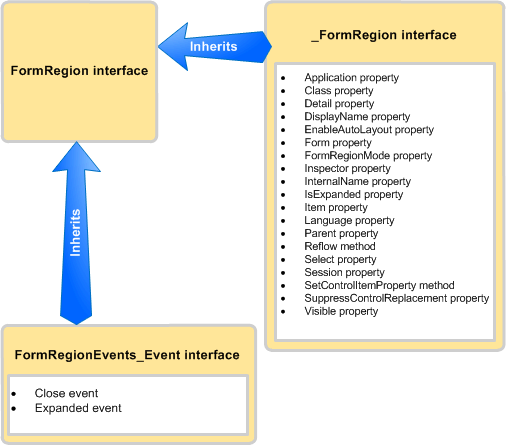Methods and properties in the Outlook PIA
This topic describes how to access methods and properties of an object in managed code by using the Outlook Primary Interop Assembly (PIA).
Where Helper objects come from
To create the Outlook PIA, Outlook uses the Type Library Importer (TLBIMP) in the .NET Framework to convert type definitions in the COM type library into equivalent definitions in a common language runtime (CLR) assembly. In COM, an object is actually a coclass that consists of the following:
The primary interface (for example, the _FormRegion interface).
The event interface (for example, the FormRegionEvents interface).
TLBIMP imports the primary interface and the event interface for each object and creates a number of interfaces, delegates, and classes, among which are the following:
The .NET event interface (for example, the FormRegionEvents_Event interface).
The .NET class (for example, the FormRegionClass class).
The .NET interface (for example, the FormRegion interface).
What the Helper objects are for
Continuing to use the FormRegion object as an example, the following list examines what each interface and class listed earlier contains.
The _FormRegion interface defines all the methods and properties of FormRegion. Typically you do not use this interface in code, except for a condition discussed below.
The FormRegionEvents interface defines methods mapping to events of FormRegion. You do not use this interface in code.
TLBIMP further processes the FormRegionEvents interface to create the FormRegionEvents_Event interface that defines all the events of FormRegion. Typically you do not use this interface in code, except for a condition discussed below.
The FormRegionClass class defines all the method, property, and event members of FormRegion. This is the class that the FormRegion interface is attributed to associate with behind the scenes so that you can write code to create an instance of the FormRegion interface. However, you do not use this interface directly in code.
The FormRegion interface inherits the _FormRegion interface and the FormRegionEvents_Event interface. Figure 1 illustrates this inheritance relationship.
Figure 1. The FormRegion interface inherits methods and properties from the _FormRegion interface, and inherits events from the FormRegionEvents_Event interface

Typically, FormRegion is the one interface you use in managed code to access the object and the method, property, and event members of the FormRegion object.
Using the Application object as another example, you access the Application object, methods, properties, and events through the Application interface. There are however three exceptions where you must use a different interface, or depending on the language, you would want to use a different interface:
When you access a method that shares the same name as an event, a good practice is to cast to the primary interface to call the method. For example, the Application object has a Quit method and a Quit event. In Visual Basic .NET, you can access the Quit method through the Application interface. In C#, you can avoid a compiler warning by casting the Quit method to the primary interface, as shown in the following code sample:
void DemoApp() { Outlook.Application myApp = new Outlook.Application(); // Other application code here ((Outlook._Application)myApp).Quit(); }When you access an event that shares the same name as a method of that object, you must cast to the appropriate event interface to connect to the event. Similar to the example above, to connect to the Quit event, you cast to the ApplicationEvents_11_Event interface.
When you connect to an earlier version of an event that has been subsequently extended in a later version of Outlook, you must connect to the version of the event in the earlier interface. For example, if you want to connect to the version of the Quit event for the Application object implemented for Outlook 2002 instead of the latest version, connect to the Quit event defined in the ApplicationEvents_10_Event interface, instead of the Quit event defined in the ApplicationEvents_11_Event interface.